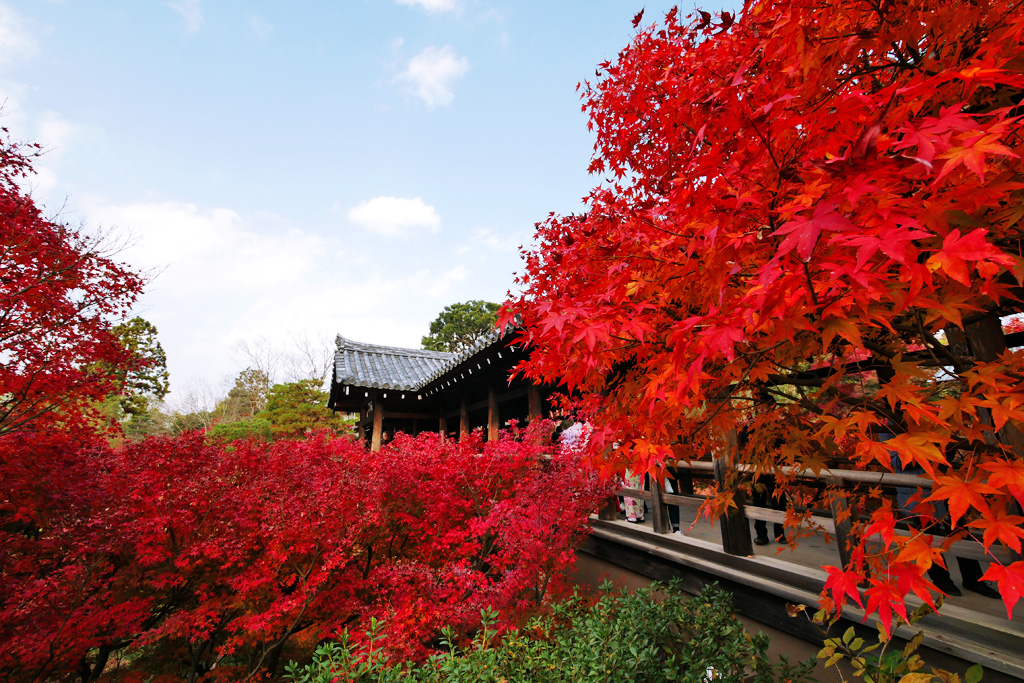
November 2024
Kyoto is one of the honourable historical places to visit in Japan. However, have you explored all the hidden Momiji (autumn foliage) spots mentioned in this blog yet? They are located some distance from the city centre and offer a journey that allows you to experience Kyoto in a way you may not have known. You will enjoy your own autumn leaves tour while getting away from your everyday life. By the end of this blog, you will have discovered red and yellow coloured hidden gems in Kyoto that only a few people know about.
You can also see the location of them from here.

※Please make sure to double-check the information as it may differ from the latest.
Web site: https://komyoin.jp/Location(Google Map): 15 Chome-809 Honmachi, Higashiyama Ward, Kyoto, 605-0981, Japan
Open : 7:00 - Sun set (Varies according to season)
Admission : 500 JPY
Access : 5 minutes walk from Tobakaido station on Keihan Main Line, 10 minutes walk from Tofukuji station on JR Keihan Line, 10 minutes walk from Tofukuji station on City bus or Keihan bus
It is famous for its elegant Karesansui garden, which consists of beautiful rocks, moss, and white stones. The stones are shaped like waves to represent the ocean. The calm shaded moss colour enhances the solemnity of the garden, giving the temple the beautiful second name, "Temple with Rainbow Moss." In autumn, the red maple leaves enhance its beauty even more.
Note: Although many of Kyoto's main temples are already well-known, its subtemples still provide a serene and delightful experience, with far fewer tourists.

※Please make sure to double-check the information as it may differ from the latest.
Web site: https://www.myoshinji.or.jp/This subtemple is usually closed to the public but opens only during the fresh green season (around April to mid-May) and the autumn leaves season (typically in November). It is located in the inner part of Myoshin-ji, allowing you to enjoy the tranquil and lush nature. During the autumn leaves season, visitors can enjoy the garden view while having matcha (Japanese green tea) and a tea treat in a traditional Japanese-style room called Shoin-Dsukuri. This hidden and peaceful moment is a limited-term offer!

※Please make sure to double-check the information as it may differ from the latest.
Web site:
https://www.jissoin.com/
Location(Google Map): 121 Iwakura Aguracho, Sakyo Ward, Kyoto, 606-0017, Japan
Open : 9:00-17:00
Admission : Adults 500JPY, Elementary and junior high school students 250JPY
Access : Kyoto Bus stop “Iwakura Jissoin”.
This is an honourable temple that was maintained among ancient royal family relatives. Visitors can enjoy two different gardens; one is centred around a pond while the other is a Karesansui garden consisting of stones arranged to represent the flow of water. Both gardens change beautifully with the seasons. The most remarkable feature is "Yuka-momiji," which refers to the reflection of leaves on the polished floor. You may not have seen such breathtaking colours before.

※Please make sure to double-check the information as it may differ from the latest.
Web site: https://www.takenotera-jizoin.jpIt is known as "Take-no-tera," which refers to bamboos and a temple since it is surrounded by verdant bamboo. The highlight of its scenery in autumn is the beautiful contrast of green bamboo and the yellow and red leaves. It is also famous for its unique prayer method. After paying a visit to Bishamonten (Vaiśravaṇa), visitors can play the piano to dedicate music to the guardian. The combination of birds' chirps, the rustling of leaves, and the piano sound provides an experience as if you are not in the real world.

※Please make sure to double-check the information as it may differ from the latest.
Web site :https://komyo-ji.or.jpLocation(Google Map): Saijo-no-uchi 26-1 Ao, Nagaokakyo, Kyoto 617-0811, Japan
Open : 9:00-16:00
Admission : Free (Autumn term - Adults ¥1000,Higher school/Middle school students 500JPY, Group over 20 800JPY)
Access : 6 min from Bus stop “Asahigaoka home mae”
The approach to the temple transforms into autumn colours. Holding beautiful coloured leaves, the branches of the trees on both sides of the path create a tunnel, and the fallen leaves also form a gorgeous carpet for visitors. This approach is called "Momiji-Sando," which literally means "Approach with Autumn Leaves to the Temple." The temple is not only beautiful but also has significant historical value. It was the first place where Honen-Shonin, the founder of the Jodo sect, initially propagated the Buddhist message.
Note: It looks the most beautiful at the dusk!

※Please make sure to double-check the information as it may differ from the latest.
Web site: https://www.ikkyuji.org/en/Location(Google Map): 102 Takigisatonouchi, Kyotanabe, Kyoto 610-0341, Japan
Open : 09:00 - 17:00 (Treasury House is open from 09:30 - 16:30)
Admission : Adult 600JPY, Higher school students 300JPY, Middle school students 300JPY, Elementary school students 200JPY, Group participants Adult 500JPY
Access : 14 min walk from Bus stop “Ikkyujimichi”
Ikkyu, the Japanese monk famous for his quick-witted ideas, spent his last years here. The temple has three gardens located in the eastern, western, and southern parts. Each garden has an independent concept, so every garden will take you on a different journey. The autumn leaves are, of course, beautiful, but noteworthy is the combination of the leaves and the valuable historical buildings. The building called Kokyu-an, which has an elegant cypress bark roof, is where Ikkyu lived in his final years.
Note: Visitors can observe this as a limited-term exhibit during a few days in November to December. The main buildings, treasury houses, and Ikkyu's statue are all important cultural assets.
Through exploring these spots, you will find Wabi-sabi, which is the Japanese cultural sense of finding beauty in quiet simplicity. Kyoto is already a world-famous tourist destination, but there are some hidden gems quietly waiting for you to discover. Once you open the door, you will find a Kyoto you have not yet known. If you are interested in this article and would like to visit, please Contact Us.
京都フリー写真素材 - https://photo53.com/